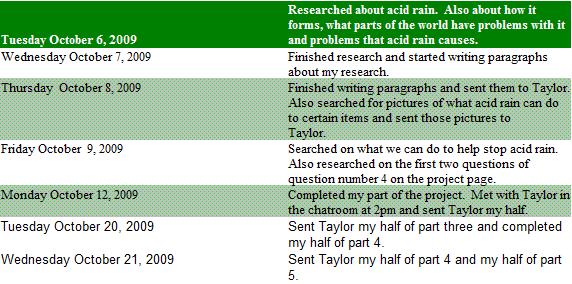
Here is an example of how acid rain forms!
Acid rain cause many problems for people and their health. Acid rain can also cause problems for animals, especially aquatic creatures that live in the water. When aquatic animals try to breath, they end up breathing in the water that is full of acid. It isn't good for humans to breath in car exhaust, so the same goes for aquatic animals. Acid rain also causes problems for the soil that plants grow in. The acid is not good for plants. The plants can no longer feed themselves, so they wither and die. Acid rain causes problems in structures that are made out of metal. Buildings, bridges and other structures made out of metal deteriorate faster than normal as a result of acid rain. As you can see, even though acid rain may sound cool, it is not when it comes to what it does to people, the environment and structures we use everyday. Most parts of the world have problems with acid rain. These areas include the northeastern parts of the United State because they have so many factories. The factories cause pollutants to rise into the air, as Taylor said before. Other areas that have a problems with acid rain include the southeastern parts of Canada, Central Europe, Scandinavia, Sweden, Norway, and Finland. Almost anywhere you go there will be a certain area of that country that has problems with acid rain.

Here is a picture of a tree branch, before and after acid rain. Can you tell which one is before, and which one is after?
Things you can do to prevent acid rain ~
We can do a lot of things to prevent the damage acid rain can cause. We can do things like turn off the power to electric appliances when they are not in use, use public transportation like a bicycle, or your feet as much as possible, and purchase a low-pollution car and use it for a long time. Open your blinds and windows for use of sunlight and if it is cool out, you can turn off your air conditioner. I got this idea from my own family because we haven't used the air the past three days because it has been so cool out lately. To help conserve energy, turn up the thermostat in your house when you are going to be gone for large amounts of time. Buying products that use less energy are also good ways to prevent acid rain.

Many lakes in Canada are being effected, please try and protect the environment!
Specific place that has problems with acid rain - Ontario Canada
Ontario is a province that is located in east central Canada. Ontario is twice the size of France and includes Canada's capital which is Toronto. Ontario is the largest province in Canada by population and only second largest in total area. This province is boarded by the provinces Manitoba in the west and Quebec in the east. Ontario is bordered by 5 U.S. states, those states include, Minnesota, Michigan, Ohio, Pennsylvania, and New York. Ontario has many lakes and rivers. Some of those rivers include the Lair River, the Marys River, and the Lawrence River. Ontario is a huge place and it has a lot more rivers and lakes but it would take a lot longer to name them all. Ontario get its name from a lake called Ontario. Acid rain has damaged at least 86 Ontario lakes and many others could suffer unless American and Canadian industries reduce sulfur emissions. Damage caused by acid deposition affects lakes, rivers, forests, soils and buildings. Sulphur dioxide in the air can combine with other pollutants and water to form particles that can increase the risk of serious health issues for people with heart and respiratory diseases. The haze that these particles form also contributes to visibility reductions, especially in parts of central and eastern Canada. Reduction of sulfur emissions in America and Canada would reduce acid rain in that area. Half of the acid rain in eastern Canada came from American sources, the U.S Clean Air Act in 1990, which specified deep cuts in sulphur emissions, is more than halfway to its reduction target and is expected to meet the 2010 deadline. There are many things people can do to prevent acid rain, and now that Madison and I are more aware of what we can do, we will put our knowledge to use.




